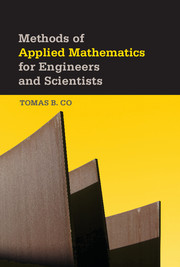Book contents
- Frontmatter
- Contents
- Preface
- I MATRIX THEORY
- III VECTORS AND TENSORS
- III ORDINARY DIFFERENTIAL EQUATIONS
- IV PARTIAL DIFFERENTIAL EQUATIONS
- 10 First-Order Partial Differential Equations and the Method of Characteristics
- 11 Linear Partial Differential Equations
- 12 Integral Transform Methods
- 13 Finite Difference Methods
- 14 Method of Finite Elements
- A Additional Details and Fortification for Chapter 1
- B Additional Details and Fortification for Chapter 2
- C Additional Details and Fortification for Chapter 3
- D Additional Details and Fortification for Chapter 4
- E Additional Details and Fortification for Chapter 5
- F Additional Details and Fortification for Chapter 6
- G Additional Details and Fortification for Chapter 7
- H Additional Details and Fortification for Chapter 8
- I Additional Details and Fortification for Chapter 9
- J Additional Details and Fortification for Chapter 10
- K Additional Details and Fortification for Chapter 11
- L Additional Details and Fortification for Chapter 12
- M Additional Details and Fortification for Chapter 13
- N Additional Details and Fortification for Chapter 14
- Bibliography
- Index
13 - Finite Difference Methods
from IV - PARTIAL DIFFERENTIAL EQUATIONS
Published online by Cambridge University Press: 05 April 2013
- Frontmatter
- Contents
- Preface
- I MATRIX THEORY
- III VECTORS AND TENSORS
- III ORDINARY DIFFERENTIAL EQUATIONS
- IV PARTIAL DIFFERENTIAL EQUATIONS
- 10 First-Order Partial Differential Equations and the Method of Characteristics
- 11 Linear Partial Differential Equations
- 12 Integral Transform Methods
- 13 Finite Difference Methods
- 14 Method of Finite Elements
- A Additional Details and Fortification for Chapter 1
- B Additional Details and Fortification for Chapter 2
- C Additional Details and Fortification for Chapter 3
- D Additional Details and Fortification for Chapter 4
- E Additional Details and Fortification for Chapter 5
- F Additional Details and Fortification for Chapter 6
- G Additional Details and Fortification for Chapter 7
- H Additional Details and Fortification for Chapter 8
- I Additional Details and Fortification for Chapter 9
- J Additional Details and Fortification for Chapter 10
- K Additional Details and Fortification for Chapter 11
- L Additional Details and Fortification for Chapter 12
- M Additional Details and Fortification for Chapter 13
- N Additional Details and Fortification for Chapter 14
- Bibliography
- Index
Summary
In this chapter, we discuss one powerful approach to obtain a numerical solution of partial differential equations. The basic approach is to replace derivatives by discrete formulas called finite difference approximations. After these approximations are applied to the given differential equations, the boundary conditions are included by modifying the equations that involve the boundary points. This often results in a large and sparse matrix equation, in which the desired values at the chosen grid points are combined as a vector or a matrix, depending on whether the problem involves one dimension or two dimensions. For steady-state cases, the unknown vector can be obtained by solving an algebraic equation. Conversely, for non–steady-state cases, algebraic iteration is used to obtain a time-marching solution.
Throughout the chapter, we limit our discussion to a discretization based on uniform grids. Under this assumption, different finite difference approximations can be formulated using the Taylor series expansions as discussed in Section 13.1. Several formulations are possible depending on the choice of neighboring points for different order of derivatives. Formulas for various approximations of first-order and second-order derivatives, including their order of accuracy, are given in Tables 13.1 and 13.2, respectively.
Once the derivatives in the differential equations are replaced with their finite difference approximations, the resulting formulas can be recast as matrix algebraic equations. We limit our applications to second-order linear partial differential equations. We first discuss the time-independent cases before moving on to time-dependent cases.
Information
- Type
- Chapter
- Information
- Methods of Applied Mathematics for Engineers and Scientists , pp. 483 - 522Publisher: Cambridge University PressPrint publication year: 2013
